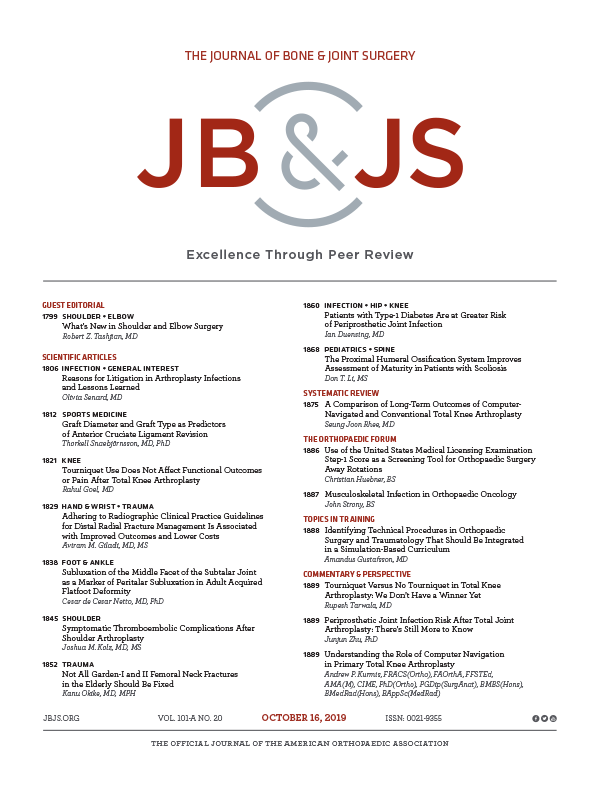
Reamed intramedullary nailing of closed tibial fractures results in fewer complications

Reamed intramedullary nailing of closed tibial fractures results in fewer complications
Randomized Trial of Reamed and Unreamed Intramedullary Nailing of Tibial Shaft Fractures
J Bone Joint Surg Am. 2008 Dec;90(12):2567-78Synopsis
1319 patients with open or closed tibial shaft fractures were included in this trial to compare the effects of reamed and unreamed intramedullary nailing approaches (Study to Prospectively Evaluate Reamed Intramedullary Nails in Patients with Tibial Fractures (SPRINT)). Patients were randomized to treatment with either reamed or unreamed intramedullary nails. The results at the 12 month follow up period indicated that fewer patients with closed fractures, treated with reamed intramedullary nailing, experienced the primary composite outcome (bone grafting, implant exchange or dynamization in patients with a fracture gap greater <1cm). However, this significant result was due to differences in autodynamization. In patients with open fractures, there was an increase in the primary composite outcome associated with reamed nailing, but this finding was not significant.
Was the allocation sequence adequately generated?
Was allocation adequately concealed?
Blinding Treatment Providers: Was knowledge of the allocated interventions adequately prevented?
Blinding Outcome Assessors: Was knowledge of the allocated interventions adequately prevented?
Blinding Patients: Was knowledge of the allocated interventions adequately prevented?
Was loss to follow-up (missing outcome data) infrequent?
Are reports of the study free of suggestion of selective outcome reporting?
Were outcomes objective, patient-important and assessed in a manner to limit bias (ie. duplicate assessors, Independent assessors)?
Was the sample size sufficiently large to assure a balance of prognosis and sufficiently large number of outcome events?
Was investigator expertise/experience with both treatment and control techniques likely the same (ie.were criteria for surgeon participation/expertise provided)?
Yes = 1
Uncertain = 0.5
Not Relevant = 0
No = 0
The Reporting Criteria Assessment evaluates the transparency with which authors report the methodological and trial characteristics of the trial within the publication. The assessment is divided into five categories which are presented below.
4/4
Randomization
4/4
Outcome Measurements
4/4
Inclusion / Exclusion
4/4
Therapy Description
4/4
Statistics
Detsky AS, Naylor CD, O'Rourke K, McGeer AJ, L'Abbé KA. J Clin Epidemiol. 1992;45:255-65
The Fragility Index is a tool that aids in the interpretation of significant findings, providing a measure of strength for a result. The Fragility Index represents the number of consecutive events that need to be added to a dichotomous outcome to make the finding no longer significant. A small number represents a weaker finding and a large number represents a stronger finding.
Why was this study needed now?
Long bone fractures are extremely common injuries, with tibial fractures being one of the most prevalent ones. Intramedullary nailing has been demonstrated to be a successful form of treatment for long bone fractures of the tibial shaft. However, much controversy exists regarding the relative benefits of reamed or unreamed nailing: unreamed nails have been reported to preserve blood supply, while reamed nails may provide increased stability. Although previous RCT's and meta-analyses have demonstrated positive effects associated with the reamed intramedullary nailing procedure, these studies were limited in quality, and therefore the effectiveness of reamed nailing remains uncertain. This study was needed to compare these two nailing approaches in a large, high quality randomized trial.
What was the principal research question?
What were the effects of reamed and unreamed intramedullary nailing on re-operation and/or autodynamization in patients with open or closed tibial shaft fractures, measured at a 1 year follow-up?
What were the important findings?
- 105 patients (16.9%) in the reamed nailing group and 114 patients (18.9%) in the unreamed nailing group experienced a primary outcome event (relative risk 0.90; 95% CI 0.71-1.15; P=0.40).
- Of all patients, 57 (4.6%) underwent implant exchange or bone-grafting due to non-union.
- In the patients with closed fractures, 113 (13.5%) underwent reoperation during the first year. (45/416 (11%) in the reamed nailing group compared to 68/410 (17%) in unreamed nailing group that experienced a primary event (relative risk 0.67; 95% CI 0.47-0.96; P=0.03)). This difference between the groups was largely due to different rates of autodynamization.
- In patients with open fractures, 106 (26.5%) underwent reoperation or autodynamization. (60/206 (29%) in the reamed nailing group compared to 46/194 (24%) in unreamed nailing group that experienced a primary event (relative risk 1.27; 95% CI 0.91-1.78; P=0.16)).
- A total of 18 patients died,14 in the reamed nail group and 4 in the unreamed group (p=0.03). Deaths were determined to be unrelated to the intramedullary nailing procedure by blinded adjudicators.
What should I remember most?
The results from this study supported the use of reamed intramedullary nailing as a treatment for closed tibial shaft fractures (reamed nailing resulted in fewer dynamizations and autodynamizations). Uncertainty remains regarding the best nailing technique for open fracture treatment.
How will this affect the care of my patients?
The use of a reamed intramedullary nailing procedure appears to provide the best outcomes for patients with closed tibial fractures. However, there is still controversy regarding the optimal intramedullary nailing treatment for patients with open tibial shaft fractures. Further trials are needed to investigate intramedullary nailing in open tibial shaft fractures to conclusively determine if one treatment is superior to another. Additionally further analyses are required to determine if certain prognostic factors are associated with negative outcomes.
Learn about our AI Driven
High Impact Search Feature
Our AI driven High Impact metric calculates the impact an article will have by considering both the publishing journal and the content of the article itself. Built using the latest advances in natural language processing, OE High Impact predicts an article’s future number of citations better than impact factor alone.
Continue



 LOGIN
LOGIN

Join the Conversation
Please Login or Join to leave comments.